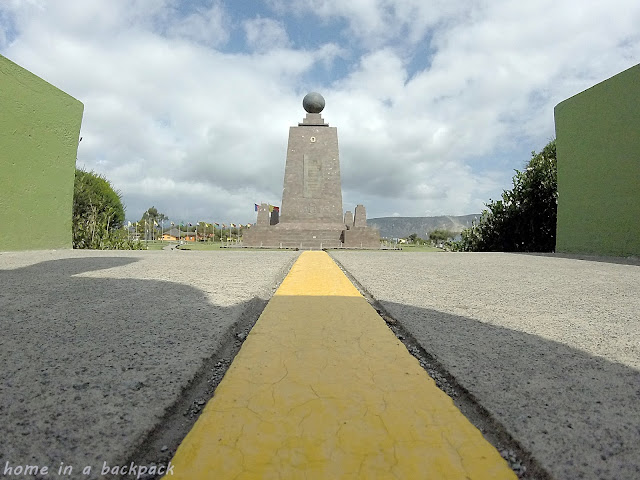- How to get there: We took a bus from Tumbes to Guayaquil for 35 soles each and in Guayaquil we took another bus for USD10 each. It takes about 12 hours to do the entire journey.
- Arriving to Quito: We had booked a hostel in a good centric area with wonderful reviews in Booking.com. "La Rosario" is a beautiful hostel close to the historical centre and the staff are very pleasant.
 |
| The middle of the world |
We arrived at 6 am to the bus station and took a taxi to the hostel which charged us USD10 to get there. We were probably overcharged but we were pretty tired and all we wanted to do was sleep, so when we arrived, we entered reception and asked to pay extra to enter the room straight away. We slept until... well, late and went out to eat and meet our friend Gustavo, who was going to show us around.
He took us, first of all, to the Estadio Olimpico Atahualpa where we had to convince the security guard to let us in the stadium to take pictures. We managed to get in and take a few pictures of the vast field and carried on driving towards the cable car that overlooks the whole city. We paid USD8.50 for a return ticket on the cable car, and went right up to 4.100m where it was hard to breathe, both due to the thin air and the spectacular views.
There are several treks you can do up there, but many recommend a tour guide since when the fog moves it can be difficult to find the way and many get lost. However, the path goes on for a few hours before needing a guide, so if you just fancy having a short walk, you might not need it.
The next day, we were picked up at midday. We picked Gustavo's wife, Lorena, up from work and went for lunch to the Inaquito market, where we ate a beautiful bowl of "encebollado" (a national dish consisting of fish soup with onion topped with popcorn. Yes, popcorn in soup) and a drink of guanabana (local fruit). We then dropped Lorena off back at work and went to another stadium, Estadio L.D.U, and again we tried to convince the security guard to let us in the stadium, unfortunately this time we couldn't get in and all we could take were pictures of the outside.
We moved on to what probably is the biggest attraction of Quito: the middle of the world, where the latitude is 000. There are several buildings, museums and shops surrounding the line that separates the northern and southern hemisphere with information about it. To be able to get into all the museums and the tour train, you will have to pay for a full pass ticket which costs USD7.50 per person. We got the basic one that costs 3.50 and just had a stroll around the area to take some pictures at the line.
We spent a couple of hours having a look around until we decided it was enough. We were dropped off at the hostel and walked back to La Mariscal, an area of restaurants and bars, to get some veggie pizza for dinner. We planned to do the historical centre the following morning, but things didn't work out as planned.
When we woke up, I went to find out about buses to Cali and get some breakfast while Oliver packed. When I came back from the shop I saw about 15 police officers that were heading to the door of La Rosario. I went up as I overheard them asking for the papers of the place, thinking it was all routine, but after being sat in the room for 5 minutes having breakfast, they knocked on our door and told us that they had to check all our bags and passports, and as they unpacked everything Oli had done in the last 15 minutes, we watched very still wondering what they wanted. They never answered our questions or told us what they were after, so we went down to reception to ask. They were looking for illegal fire arms and alcohol and the raid is just a routine for every hotel.
We ended our time in Quito in a very curious way, and even though most people would be scared enough to not go there after this experience, I am sure we will be back to Ecuador for more, to discover more of this diverse country.
 |
| Atahualpa stadium |
 |
| Atahualpa stadium |
 |
| Gustavo and Oli at the Atahualpa stadium |
 |
| Cable car overlooking Quito |
 |
| Gustavo pointing at Quito |
 |
| Quito from the air |
 |
| At the top of Quito |
 |
| Altitude 4.100 warning
|
 |
| Trek at 4.100 |
 |
| Trek at 4.100m |
 |
| Quito's highest church perhaps
|
 |
| Church in Quito |
 |
| Inaquito market
|
 |
| Fish and chips at Inaquito market |
 |
| Guanabana fruit and juice |
 |
| encebollado |
 |
| pork at the Inaquito market
|
 |
| LDU stadium |
 |
| UNASUR in the middle of the world |
 |
| The middle of the world |
 |
| Oliver stands in both hemispheres |
 |
| shops around the middle of the world |























































